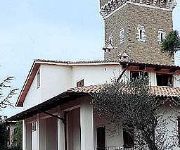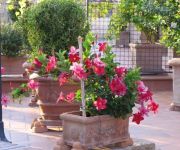Facts and Data
Webpages:
Official Unesco Page
Comune di Pienza (only in Italian)
Basis Data:
Unesco World heritage since: 1996
Size of heritage: 4.41 ha
Coordinates:
Longitude: 11,679°
Latitude: 43,077°
Summary
It was in this Tuscan town that Renaissance town-planning concepts were first put into practice after Pope Pius II decided, in 1459, to transform the look of his birthplace. He chose the architect Bernardo Rossellino, who applied the principles of his mentor, Leon Battista Alberti. This new vision of urban space was realized in the superb square known as Piazza Pio II and the buildings around it: the Piccolomini Palace, the Borgia Palace and the cathedral with its pure Renaissance exterior and an interior in the late Gothic style of south German churches.
Location on Map
Show bigger map on Openstreetmap
Historic Centre of the City of Pienza: A Jewel of Renaissance Urban Planning
The Historic Centre of the City of Pienza, located in the Province of Siena, Tuscany, Italy, is a UNESCO World Heritage site that showcases the remarkable achievements of Renaissance urban planning. This small town, originally known as Corsignano, was transformed into an ideal Renaissance city by Pope Pius II in the 15th century.
Pienza's history dates back to the Etruscan period, but it was during the Renaissance that it gained prominence. Pope Pius II, born Enea Silvio Piccolomini, envisioned creating an ideal city that would reflect the humanist ideals of the time. He commissioned the renowned architect Bernardo Rossellino to redesign Corsignano, transforming it into a harmonious and balanced urban space.
The historic centre of Pienza is a testament to the principles of Renaissance urban planning. The layout of the city follows a grid pattern, with three main streets intersecting at the central square, Piazza Pio II. The buildings are characterized by their elegant facades, harmonious proportions, and use of local materials such as travertine stone.
One of the most iconic buildings in Pienza is the Cathedral of Santa Maria Assunta. Its facade, designed by Rossellino, is a masterpiece of Renaissance architecture. The cathedral's interior houses beautiful frescoes by Sienese artists, including the renowned painter Pinturicchio.
Another notable building is the Palazzo Piccolomini, the former residence of Pope Pius II. This grand palace features a stunning courtyard and a loggia with panoramic views of the Val d'Orcia, a picturesque landscape that surrounds Pienza.
Pienza's historic centre is also home to numerous other palaces, churches, and public buildings that contribute to its unique character. The town's narrow streets, lined with charming shops and cafes, invite visitors to explore its rich history and enjoy the local cuisine.
Today, the Historic Centre of the City of Pienza remains remarkably well-preserved, allowing visitors to experience the splendor of Renaissance urban planning. The site was inscribed on the UNESCO World Heritage list in 1996, recognizing its outstanding universal value.
Pienza's inclusion on the World Heritage list has helped to raise awareness about the importance of preserving its cultural heritage. Efforts have been made to protect and restore the historic buildings, ensuring that future generations can continue to appreciate the beauty and significance of this exceptional Renaissance city.
Visiting the Historic Centre of the City of Pienza is like stepping back in time to the golden age of the Renaissance. Its architectural masterpieces, combined with its picturesque setting in the heart of Tuscany, make it a must-see destination for history and culture enthusiasts alike.
Hotels and places to stay
Hotel Corsignano
Relais Il Chiostro di Pienza
Piccolo Hotel La Valle
Hotel Arca di Pienza
Albergo Rutiliano
LA BANDITA
Il Giglio B&B
Agriturismo Barbi
LA BANDITA TOWNHOUSE
Agriturismo Il Colombaiolo
Videos from the area
Videos provided by Youtube are under the copyright of their owners.
















